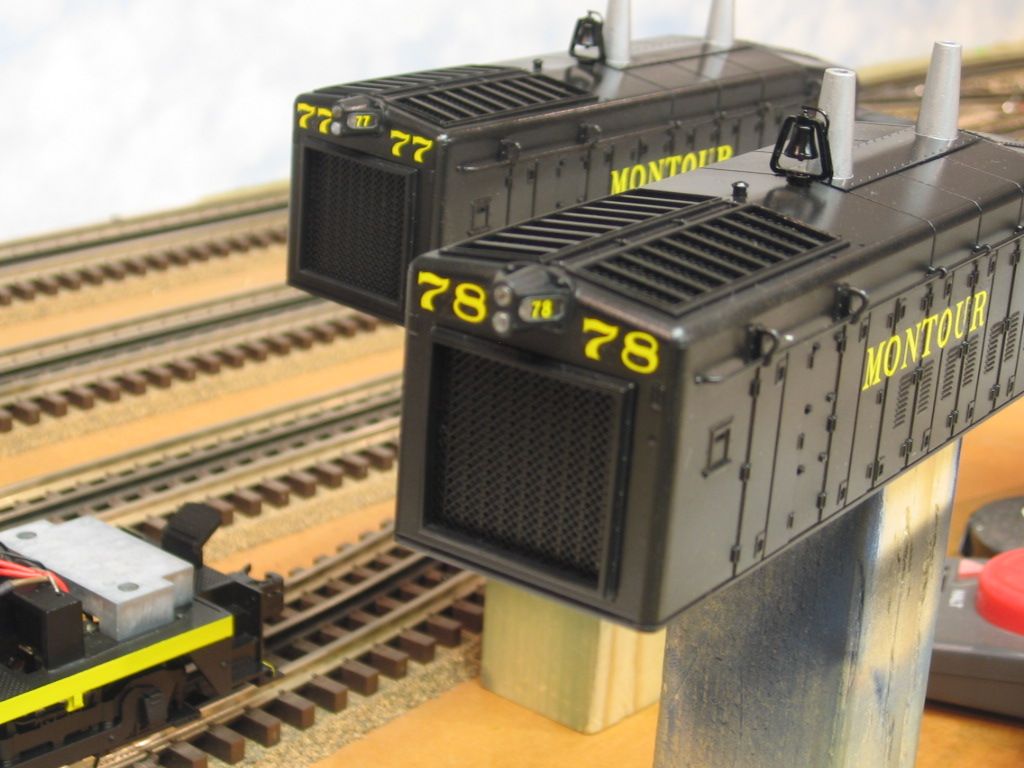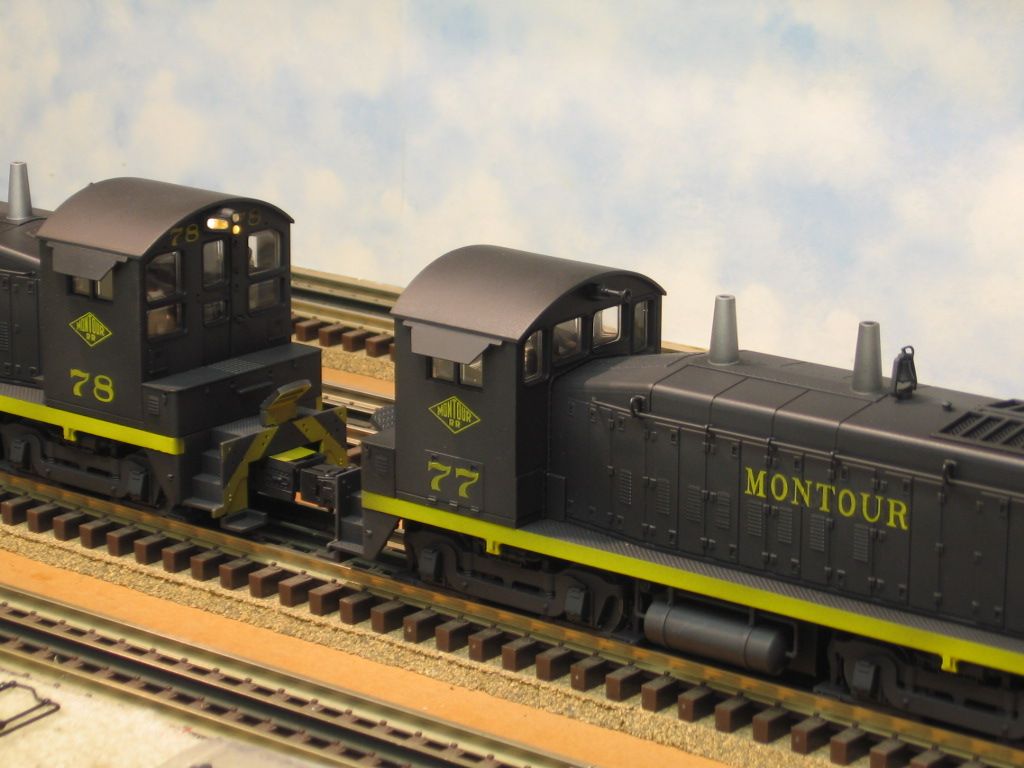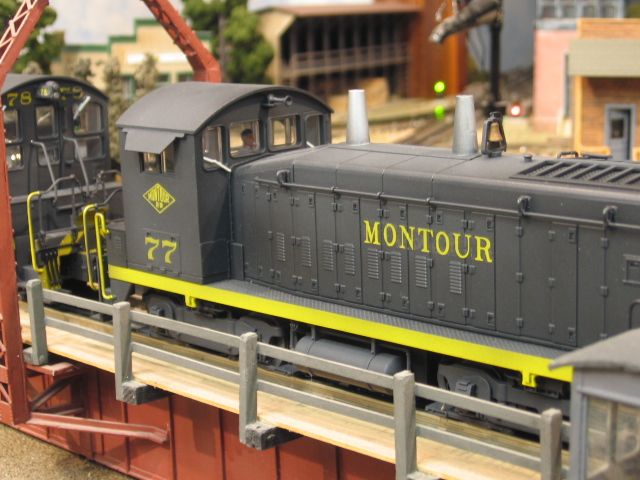I've begun to re-purpose some miscellaneous Postwar and MPC rolling stock to PRR. This is my first attempt at repainting and decals.
Foreground is an MPC gondola in the works. Middle is a spare Postwar gondola complete on both sides. The back is the Postwar gondola I was using as a model.
I've used Testor's inkjet decal sheets, and that seemed to work fine. However, I can still see the semi-gloss sheen on fhe decals. I've tried a few coats of dull-coat, but this didn't seem to help.
So what is the trick of blending the decals into the rest of the car?
Thanks!
Replies sorted oldest to newest
I can't tell from the photo, but did you apply gloss coat before you applied the decals? I've found that if you put the decals on a matte finish, they'll never lay down right.
On these I just used a flat primer.
I'm working on a limited budget, and I already had the primer sitting in the basement.
It's been said that one can apply decals over a flat surface, use enough solva set and they'll lay fine without air bubbles, but I haven't had good luck there with that....add I've had issues with the difference in sheen too on my flat finished builds. My practice has been a coat of gloss clear...future floor coating{really- it's acyrlic and sprays straight thru an airbrush!}, then decal, then flat coat{armor/ship models}. Glossy models{semi trucks/cars} weren't a problem with sheen difference.
My few issues with that decal making system was that sometimes the decals would bleed alittle when applied and/or finish coated...maybe I went alittle too thin on those with the finish sealer before applying.
As a side note- I've learned long ago that one needs to trim as close to the decal as possible to remove the backing clear sheet so there's only the actual decal left...this hides the clear backing and keeps it from being seen so easily...and nope, lettering isn't an easy task nor do-able sometimes...just rim as much as you can away.
This may sound odd, but try a glossy coat over them, then follow up when dry with a flat clear coat.
I've got 3 lil lionel gons that need a repaint, so I'll be trying this out soon too...
After the decals are applied I always add a layer of gloss coat. It blends in the decal film. When it is totally cured I then add my dullcoat.
You can never hide 100% but like the guy's are saying, Gloss coat first for the best results.
Thanks for all the tips!
Question: do you gloss coat only the area where you intend to put the decals (i.e. the side of the gondola) or do you cover the entire car? I would imagine coating only the side would conserve on the gloss coat, and later dull coat.
This may end up as a project that gets picked up again in Spring. I'm losing good weather. I'm stuck with rattle cans and the great outdoors -- nowhere inside for a spray booth.
I'm glad I'm sorting this out after only decaling 1 1/2 cars.
I have 5 in gray (all gondolas).
Another 6 that will be Tuscan (both hoppers and gondolas). Currently they are in a terrible wine colored primer. Had to special order the Tuscan as Testor's is discontinuing it.
And yet another 5 in black (both hoppers and flat cars).
I also have one tool car that I'm painting for M.O.W. in dark yellow.
Thanks again!
Attachments
First of all, did you use Walther's Solvaset (stronger/better) or Micro-Sol setting solutions?
Absolutely necessary. Solvaset can chew up Microscale decals, though - they're too
thin, really. (Gosh, I miss Champ Decals, right along with K-Line...)
------------
Anyway:
I have had excellent results putting decals on flat paint - most of the time. Sometimes,
not so much.
So, much as I hate to bother, I use the flat/Glosscote/Dullcote routine, too. More dependable, especially when applying decals to a "weathered black" (dark flat gray) color on a steamer.
Stick with the Testors Gloss/Flat Brothers; after having a couple of things ruined by
compatibility issues (Valspar/Krylon/R-Oleum/whatever clear coatings), I threw all that away - literally - and went back to the tried-and-true.
Cost? "Oh, sure I saved $1.25, and all I ruined was a decal set, a paint job, hours of
labor and maybe some plastic surfaces..."
Those kinds of savings will cost you a fortune.
I have not yet gotten Microsol, though that is on my list to get. Along with white film inkjet sheets for the lettering on the Tuscan and black cars.
So far I'm not in too deep that I can't make a course correction! I can't call these cars 'box queens' -- perhaps 'box bums' -- since they weren't being run in their original colors. And I've not messed anything up past redemption. All part of the learning process!
And thanks yet again!
Having one of those 'ah-ha' moments... and feeling slightly stupid.
Looking on the Micro-Mark site for Glosscote. You mean it is the same stuff I used to seal the decals?!? The stuff in that can within arms reach of me?!? *sigh*
I did a gloss coat on the units before I installed the decals. Then Dull coat and dusted with grimy black.








It's been said that one can apply decals over a flat surface, use enough solva set and they'll lay fine without air bubbles
What's funny is, that is the way I always did it (never had a problem) until someone told me I was doing it wrong!
Those thin MicroScale decals (use ONLY MicroSol & MicroSet and do not touch until dry) would disappear after a few coats of Floquil Flat Finish (which really gives a satin rather than flat finish).
But, as many here say, decaling over a smooth surface really is easier than doing it over a truly flat finish because of air bubbles getting trapped under the surface causing silvering.
Solvaset will absolutely eat up MicroScale decals.
It's been said that one can apply decals over a flat surface, use enough solva set and they'll lay fine without air bubbles
Solvaset will absolutely eat up MicroScale decals.
Not true, it simply makes the decals "very" loose in order for them to settle down over rivets and into cracks...once you apply solva-set you don't touch it or you will screw up the decal...especially microscale decals{thin}. Took me 3 coats of solva-set to get my recent microscale CB&Q decals to settle in over the tender rivets. Although it will seem they've wrinkled up and got ruined they will lay back out...we do what we gotta do to get the decals to settle in over things{rounded cycle fenders/rivets/door seems....
As for decalling over flats...sure, can be done, but I have too many times before I changed where the decals silvered{air bubbles} and had to pin prick the snot out of them to get them to settle down and de-bubble...using a gloss coat makes the job just that much easier, so that's how I've done it since.
To each they're own, so long as it works...
Well, it has eaten up every MicroScale decal I have ever used. Never again.







